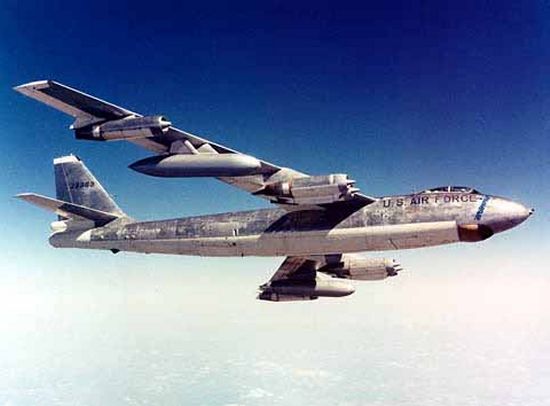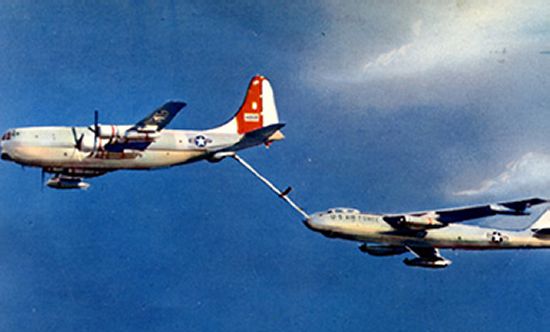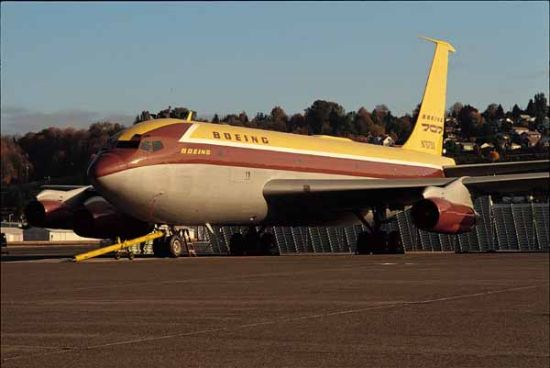|
||||||||||
|
|
||||||||||
|
||||||||||
|
|
||||||||||

During the 1930s and 1940s, the company model numbers were well into the 200s and 300s. The famous B-17 Flying Fortress was known internally as the Boeing Model 299. Other well-known designs of the period included the Model 314 Clipper, the flying boat that ushered in the age of airline travel, and the Model 345, better known as the B-29 Superfortress.
By the start of the jet age, Boeing had progressed to the 400s. Some of its better known designs included the B-47 Stratojet (Model 450) and B-52 Stratofortress (Model 464). These two aircraft made Boeing the nationally-recognized leader in the design and construction of large, jet-powered aircraft. This wealth of experience would prove vital in producing the country's first commercial jetliner.

The effort began when Boeing initiated a study of a turbojet-powered version of the KC-97 Stratofreighter. Known internally as the Model 367, the KC-97 was a piston-engined derivative of the B-29 developed as an in-flight refueling tanker for the B-47 and B-52. The same design had also been adapted as the Model 377 Stratocruiser commercial airliner. Although Boeing was eager to develop a jet-powered airliner to replace the Model 377, the company knew that airlines would not commit to the enormous development costs required. It was instead hoped that the US Air Force would fund development of the jet-powered variant of the KC-97, and the final product could then be adapted into a civilian spin-off.

Unfortunately, the Air Force showed no interest in the proposal, and it was rejected in 1951. Boeing instead decided to commit over $15 million of company funds to develop the turbojet-powered transport, convinced that the USAF would eventually buy it anyway. Owing to its legacy as a derivative of the Model 367 and in an effort to maintain secrecy, the new project was dubbed the Model 367-80, popularly known as the "Dash-80" by Boeing employees. However, the Dash-80 soon evolved far beyond its initial concept. The design ultimately became much larger, with a longer, wider, and more streamlined fuselage able to hold 130 passengers. The overall "figure-8" fuselage shape was derived from the KC-97 and Stratoliner, but faired over to improve aerodynamics. Otherwise, the design was largely inspired by the B-47, having borrowed the bomber's 35° swept-wing and the mounting of its turbojet engines on underwing pylons.

By the time the Dash-80 made its first flight in 1954, the Air Force had changed its mind about the project and soon ordered 29 as KC-135 tanker/transports. Airline interest was somewhat slow in coming, however, so Boeing officials looked to give the project a new, more memorable name. The Model 367-80 had never been intended as anything more than an internal designation. Models in the 500s had been reserved for gas turbine engines and the 600 series for missiles. The 700 series was again intended for aircraft, so the company board decided to officially christen the Dash-80 as the Model 707.
Indeed, many of Boeing's most successful products over the years had had a connection to the number 7. These included the Model 75--hundreds of which were used as trainers during World War II, the Model 77--one of the first carrier-based fighters, the Model 247--considered to be the prototype of the modern airliner, the B-17 Flying Fortress--of which 13,000 were built for use during World War II, and the Model 314 Clipper--greatest of the passenger flying boats. Other notable aircraft included the B-29 Superfortress (i.e. 9-2=7) that saw great success in the Pacific Theater of World War II and was developed into a number of derivatives, including the Model 367 and Model 377, as well as the B-47 Stratojet and B-52 Stratofortress (5+2=7).
With over 1,000 built by the time production closed in 1991, the 707 proved such a huge success that Boeing decided to retain the same naming convention for nearly all of its future jetliners. One exception was the Model 717 which was originally given to the military version of the 707, better known as the KC-135. However, that designation did not last and was later briefly given to a different commercial derivative of the 707. Even later, it was applied to the MD-95 after Boeing had acquired its former rival McDonnell Douglas. As the only McDonnell Douglas production line to remain open for long after the merger with Boeing, the MD-95 was re-christened the 717 in 1997. The only other unusual case was the Model 720, a shorter range version of the 707 developed for domestic use. The 720 began life as the 707-020 and was later briefly known as the 717-020 before the Model 720 became official.
Otherwise, Boeing has retained the 7-7 convention for the past fifty years, having applied it to its entire family of commercial jetliners:
As for the plane that started it all, the Dash-80 still holds an honored place in aviation history. The
prototype was a workhorse for 18 years, serving as a Boeing flying test laboratory for new technologies. Over the
course of its career, the aircraft was heavily modified to test aerodynamic and structural changes as well as
advanced features that were incorporated into later planes. Among these modifications were new wing planform and
leading edge shapes, airfoil designs, leading-edge and trailing-edge wing flap concepts, and new engines. The
Dash-80 even carried a fifth engine in an aft-mounted pod to evaluate a concept for the 727. The historic aircraft
was finally retired in 1972 when it was donated to the National Air & Space Museum. However, the Dash-80 remained
stored at the Davis-Monthan Air Force Base desert storage facility until
1990. At that time, the Smithsonian agreed to return the prototype to Boeing's facilities in Seattle for a full
restoration to its original form. There the Model 367-80 has remained, being displayed at Boeing Field. It is due
to be transferred to the National Air & Space Museum
Steven F. Udvar-Hazy Center in the fall of 2003.
- answer by Joe Yoon, 27 July 2003
Related Topics:
Read More Articles:


|
Aircraft | Design | Ask Us | Shop | Search |

|
|
| About Us | Contact Us | Copyright © 1997- | |||
|
|
|||